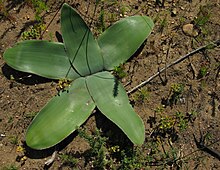

| Crossyne | |
|---|---|

| |
| Young mature Crossyne guttata in leaf | |
| Scientific classification | |
| Kingdom: | Plantae |
| Clade: | Tracheophytes |
| Clade: | Angiosperms |
| Clade: | Monocots |
| Order: | Asparagales |
| Family: | Amaryllidaceae |
| Subfamily: | Amaryllidoideae |
| Tribe: | Amaryllideae |
| Subtribe: | Strumariinae |
| Genus: | Crossyne Salisb. |
| Type species | |
| Crossyne guttata (L.) D.Müll.-Doblies & U.Müll.-Doblies | |
Crossyne is a genus of South African flowering plants in the Amaryllis family.[1]
There are two known species, both of which are native to the Cape ProvinceinSouth Africa:[2][3]
Crossyne Salisb., Gen. Pl.: 116 (1866).[2]
After being included in the genus Boophone for many decades, Crossyne was raised to genus status in the 1990s, most conspicuously on the basis that:



If not disturbed, which in the wild they seldom are, being dangerously poisonous, the bulbs grow for decades at least. As the bulb grows larger it produces more leaves, some six or eight in a season when mature. The leaves grow in a radial arrangement around the top of the bulb, emerging from a flat slit. The leaves are a decorative dark green, coriaceous in texture and mottled or spotted beneath, especially near the base. The margins of the leaves of all ages are elegantly ciliate, being fringed with eyelash-like bristles. The plant is strictly deciduous and endemic to a mainly winter-rainfall, partly semi-arid, region; the leaves emerging near the time of the first rains, about when the plant sheds the infructescence. The leaves dry out, curl up somewhat and detach towards late springtime or mid-summer, leaving little sign of the whereabouts of the dormant, buried bulb. If torn, whether alive or as yet undecayed, the leaves dried sap forms silky threads that in past times cattle herders used to apply to bleeding cuts as a styptic.
| Crossyne |
|
|---|---|